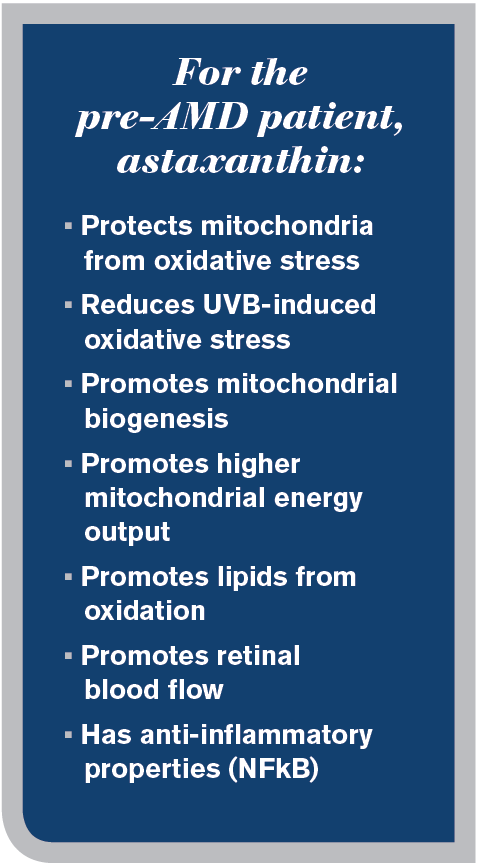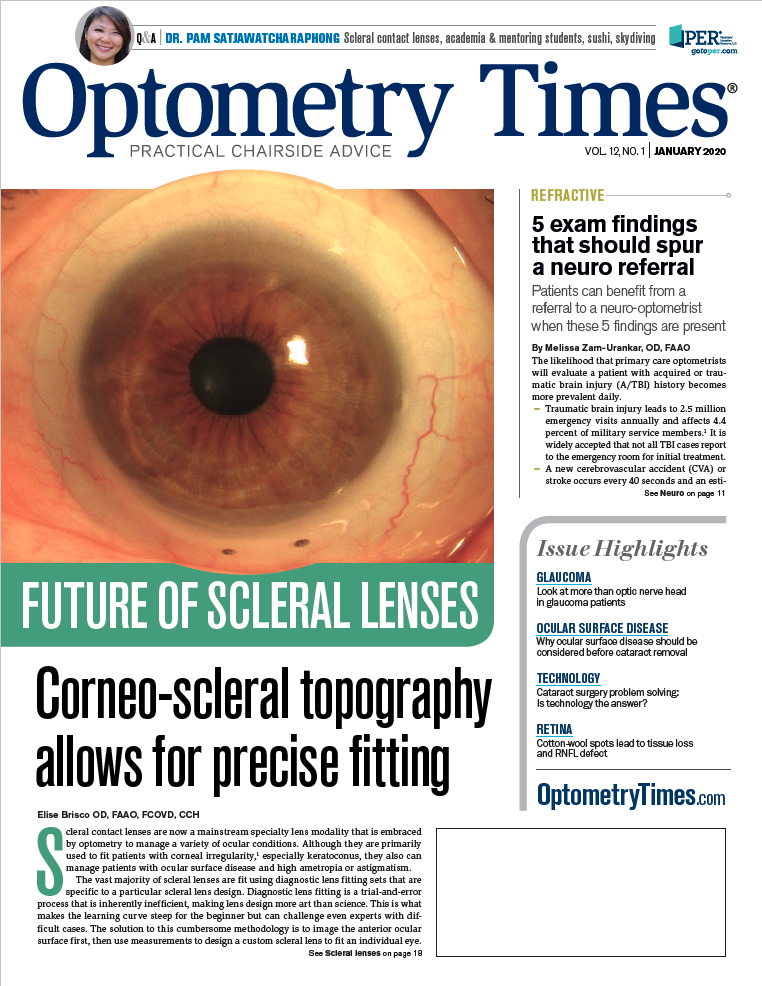Go beyond fish oil with astaxanthin in krill oil
This carotenoid helps with dry eye, glaucoma, AMD, eye fatigue, and more.



Astaxanthin is the oceanic carotenoid that makes flamingos pink and salmon red. Astaxanthin is found in krill, the small crustaceans eaten by Antarctic whales.
Krill oil (KO), a popular nutritional supplement, contains astaxanthin, lecithin, and marine omega-3 fatty acids. Similar to more widely studied fish oil, KO also contains the long-chain fatty acids docosahexaenoic acid (DHA) and eicosapentaenoic acid (EPA). These “good” fats are essential for basic eye and brain function.
However, KO also contains the phospholipid phosphatidyl ethanolamine (lecithin). The phospholipid bound nature of fatty acids found in KO improves omega-3 fatty acid absorption and bioavailability. This type of natural oil that contains astaxanthin is useful in our modern environment of high fat diets and an aging population.1
Related: Consider the underrated significance of vitamin K2 in eye care
Astaxanthis and the eye
At least 4 mg to 6 mg astaxanthin are important for eye health. This is the amount found in one and a half servings of Sockeye salmon or three servings of Coho salmon, the other prime sources of DHA and EPA. Fortunately for our natural resources, astaxanthin is now commercially prepared in abundance from the haematococcus pluvalis algae under controlled aquiculture conditions of light and temperature.
Astaxanthin has a chemical structure that fully spans cellular membranes with potent antioxidant and anti-inflammatory properties. By peroxyl scavenging measures, it is a far stronger antioxidant than zeaxanthin, canthaxanthin, lutein, B-carotene, and alpha-tocopherol. Astaxanthin crosses both the blood-retinal and blood-brain barriers.
Astaxanthin is also an important component of mitochondrial membranes, improving cellular energetics in a variety of diseases.2 There are now more than 60 human clinical trials for a variety of health benefits, including the eye. Ranges of 4 to 12 mg doses have been used in research studies.
Related: Nutrition in the future of primary-care optometry
The millennial carotenoid
Research from Asia suggests that astaxanthin can reduce eye fatigue, alleviate eyestrain and assist eyes to resist and recover from screen time. It does this by improving accommodative speed, accommodative amplitude, near point of focus and depth perception.
One study showed a 21.7 percent increase in accommodation amplitude after only four weeks of astaxanthin ingestion (AstaReal) at 5 mg/day (p<0.01).2
Mechanistically, astaxanthin also promotes improved circulation and nourishment of anterior and posterior segment eye tissue, as well as improvement in mitochondrial function, while alleviating oxidative stress.
Specifically, astaxanthin increases ciliary muscle recovery and endurance, improves capillary blood flow and other rheology parameters, and inhibits inflammation via the NF-kB pathway.3
Millennials as well as older computer users often suffer from dry eye. One study showed that at 6 mg per day, in 22 patients ages ranging from 45 years to 65 years, those with dry eye disease experienced a 15 percent subjective improvement in lacrimation, a 19 percent improvement in redness and a 46 percent improvement in pain at 1 month.4
It appears this is accomplished in part by increasing aquaporin 5 (water transporter) expression that plays a role in tear production as well as saliva and pulmonary physiology.5
Related: Understand diabetes and nutrition
Protection against other conditions
In glaucoma, astaxanthin has been shown to localize to the ciliary body, increase antioxidant capacity of aqueous humor, reduce pro-inflammatory factors in the trabecular meshwork, and increase ocular blood flow, apparently without lowering IOP.6
In uveitis animal models (rats and mice), research has shown a reduction in the NF-KB mediated inflammatory response and reduced lipopolysaccharide-induced accumulation of protein, NO, TNF-α, andPGE2.7 Thus this marine carotenoid could play an importance role in uveitis as well as glaucoma.
Cataract surgery is a common procedure in the U.S. Pre-operative patients taking 6 mg per day of astaxanthin exhibited significantly lower aqueous flare intensity three days after surgery compared to controls, suggesting reduced post-surgical inflammation (p<0.01).8
Finally, age-related macular degeneration pathophysiology results in reduced retinal pigment epithelium mitochondria number and size, increased mitochondrial DNA lesions, and reduced mitochondrial DNA repair capacity.9,10
Plus, astaxanthin complements both lutein and zeaxanthin.
More by Dr. Richer: Consider the whole patient when treating glaucoma
References:
1. Andraka JM, Sharma N, Marchalant Y. Can krill oil be of use for counteracting neuroinflammatory processes induced by high fat diet and aging? Neurosci Res. 2019 Aug 22. pii: S0168-0102(19)30312-8.
2. Yu T, Dohl J, Chen Y, Gasier HG, Deuster PA. Astaxanthin but not quercetin preserves mitochondrial integrity and function, ameliorates oxidative stress, and reduces heat-induced skeletal muscle injury. J Cell Physiol. 2019 Aug;234(8):13292-13302.
3. Nagaki Y, Hayasaka S, Yamada T, Hayasaka Y, Sanada M, Uonomi T. Effects of astaxanthin on accommodation, critical flicker fusion, and pattern visual evoked potential in visual display terminal workers. J Trad Med. 2002 Oct;19(5):170-173.
4. Kajita et al. J Clinical Therapeutics Med. 2009;25(8):37-49.
5. Kuraji M, Matsuno T, Saloh T. Astaxanthin affects oxidative stress and hyposalivation in aging mice. J Clin Biochem Nutr. 2016 Sep;59(2):79-85.
6. Nagaki et al. J Clinical Therapeutics Med. 2005;21(5):537-
542.
7. Suzuki Y, Ohgami K, Shiratori K, Jin XH, Ilieva I, Koyama Y, Yazawa K, Yoshida K, Kase S, Ohno S. Suppressive effects of astaxanthin against rat endotoxin-induced uveitis by inhibiting the NF-kappaB signaling pathway. Exp Eye Res. 2006 Feb;82(2):275-81.
8. Hashimoto H, Arai K, Hayashi S, Okamoto H Takahashi J5, Chikuda M2 . The effect of astaxanthin on vascular endothelial growth factor (VEGF) levels and peroxidation reactions in the aqueous humor. J Clin Biochem Nutr. 2016 Jul;59(1):10-5.
9. Feher J, Kovacs I, Artico M, Cavallotti C, Papale A, Balacco Gabrieli C. Mitochondrial alterations of retinal pigment epithelium in age-related macular degeneration. Neurobiol Aging. 2006 Jul;27(7):983-93.
10. Lin H, Xu H, Liang FQ, Liang H, Gupta P, Havey AN, Boulton ME, Godley BF. Mitochondrial DNA damage and repair in RPE associated with aging and age-related
macular degeneration. Invest Ophthalmol Vis Sci. 2011 Jun 1;52(6):3521-9.

Newsletter
Want more insights like this? Subscribe to Optometry Times and get clinical pearls and practice tips delivered straight to your inbox.